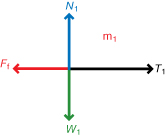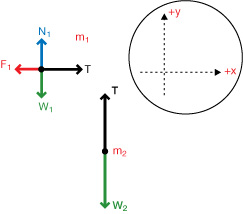Module 3—Effects of Force on Velocity
How to Create Equations from Free-Body Diagrams
Using free-body diagrams, it is possible to generate equations that can be used to predict the magnitude and direction of forces or accelerations, or both. The simulation will be used to demonstrate how this is done.
On the simulation, select an FBD using the “Image” button (![]() ) and selecting the upper right-hand FBD. Click OK. There are now two masses in the system; therefore, you must make two FBDs, one for each mass. On the applet display, draw and name all of the forces you think are acting on each block.
) and selecting the upper right-hand FBD. Click OK. There are now two masses in the system; therefore, you must make two FBDs, one for each mass. On the applet display, draw and name all of the forces you think are acting on each block.
- The FBD for m1 will be identical to the one you made in the procedure.
- The FBD for m2 should show only two forces: weight and tension.
Verify your FBDs when you are done by clicking “Check” (![]() ) and selecting “FBD” (
) and selecting “FBD” (![]() ).
).
 Self-Check
Self-Check
SC 2. Draw the correct FBDs on a copy of the diagram on the right.


 Self-Check Answers
Self-Check Answers
SC 2.
Here are the FBDs shown for the masses connected by a rope and pulley without mass. Note that a set of coordinate axes has also been drawn. You must draw it yourself—the simulation will not assign or draw a coordinate axis. Choose the “Draw New Vectors” mode (![]() )and draw and label the coordinate axes.
)and draw and label the coordinate axes.


![]()
 Self-Check
Self-Check
SC 3. Identify the coordinate axes on the diagram above and to the right, and explain in words what it means.
 Self-Check Answers
Self-Check Answers
SC 3.
The coordinate axis defines up and right as positive directions and down and left as negative directions.
Choosing coordinate axes is essential for correctly assigning the direction of each force. Any force pointing in the +x or +y directions will be treated as positive, and any force in the opposite directions will be treated as negative.
 Self-Check
Self-Check
SC 4. The FDBs for the masses connected by a rope and pulley without mass, including coordinate axes, looks like this.


![]()
Use the words positive or negative in the blanks below to indicate the directions of the force vectors
 ______________________
______________________-
 _______________________
_______________________ -
 ______________________
______________________ -
 ______________________
______________________ -
 _______________________
_______________________
 Self-Check Answers
Self-Check Answers
SC 4.
 positive
positive negative
negative negative
negative negative
negative
-
 positive
positive
Now it is possible to write simple equations describing the forces along the x- and y-axis for each body. This is done using Newton's second law and the fact that the net force along each axis is always the sum of all the forces acting along that axis.
Equations for Mass 1
The net force along the x-axis is the sum of all forces acting along the x-axis. Tension points in the positive direction, and the force of friction is in the negative direction.


According to Newton's second law, Fnet = ma. Therefore, the equation to determine the acceleration of the mass along the x-axis is
![]()
The net force along the y-axis is the sum of all forces acting along the y-axis. The normal force points in the positive direction, and the weight points in the negative direction. The mass is not accelerating in this direction; therefore, the magnitude of each of these vectors is identical and the net force along the y-axis must be zero.

Equations for Mass 2
The net force along the y-axis is the sum of all forces acting along the y-axis. The tension force points in the positive direction, and the weight points in the negative direction. Also, mass 2 is accelerating in the downward direction; therefore, the y equation for mass 2 is
